
The Golden Temple
Also known as Harmandir Sahib, it is the most revered shrine of the Sikhs. The name Golden Temple originated as the sanctum sanctorum Akal Takht has its roof covered with pure gold plates. The Sikhs from all over the world come to visit the shrine at least once in their lifetime. The four gates in four cardinal directions are an open invitation to all to visit the shrine.
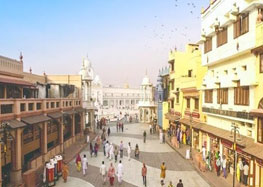
The Golden Temple Plaza
This design is the shortlisted entry for the pitch for the Entrance Plaza of the Golden Temple in Amristar, Punjab, India. The design aims to create a new ritual within the boundaries of the existing temple rituals at this holy place, a clockwise walk underneath a laser cut marble roof. During the clockwise walk the visitor can read the first book of the Gurdwara, the holy book, in the shadow pattern on the floor. The designed minimal roof creates a square within a lost public space, shade for the visitors and a new destination for all visitors. The physical movement of people within and outside the temple complex constantly asserts the importance of Harmandir Sahib with an alternating circular and radial movement patterns while the temple complex itself forms a neutral canvas to accommodate these movements. The new interventions in the plaza will reproduce these relations as a contextual response to form a space with an ethereal con
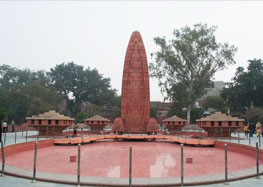
Jallian Wala Bagh
It gained its place in the annals of the Indian freedom struggle when British General Reginald Dyer mercilessly gunned down hundreds of innocent men, women and children who had gathered in the park on the day of Baisakhi in 1919. The park symbolizes the atrocities committed by the British on the Indian soil.
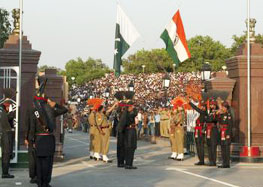
Wagah Border
When the sun decides to say goodbye to a peaceful day its time For the reunion, which transcends the boundaries, that man has laid. From Amritsar 35 Km on the road to Lahore(Pakistan), is India-Pakistan border,which is also known as "Attari(India)-"Wagah" (Pakistan) border. A visit to the border is an interesting experience, especially at sun-set, when the retreat ceremony takes place with the Border Security Force (B.S.F.) on the Indian side and The Sutlej Rangers on the Pakistan side putting up a well co-ordinated and spectacular display which compares very favorably with the changing of royal guard in London.
The sound from the bugles blown together from both sides paints past on the canvas when India and Pakistan were one, simultaneously Flags of the two nations are ceremoniously retrieved and lights are switched on marking the end of the day amidst thunderous applause. Today this point is only land route to approach Pakistan and central Asia.
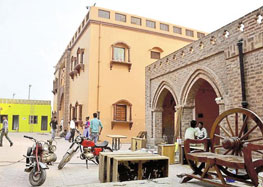
Sadda Pind
Imagine a bustling village in Punjab. Beautiful mud houses, lassi being churned, men busy in animated discussions on their charpais, children climbing trees, artisans creating something beautiful, a woman singing a soulful melody, a group of youngsters breaking into a joyful dance...
Sadda Pind is a Punjabi Village resort spread across 12 acres of land. It brings you a chance to experience authentic culture, colours and flavours of Punjab in one place.
Situated in the holy city of Amritsar, just 8 kms from Golden Temple, Sadda Pind offers a perfect setting for a weekend getaway or a short stay with family and friends.
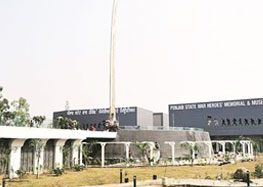
Amritsar war memorial
The Amritsar war memorial, spread across seven acres of land has a 45-metre high iconic sword, fighter aircrafts and battle tanks to boast of. It also has a 7-D theatre, museum, landscaping, history about wars and the names of the heroes.

Ram Bagh
The landscaped garden with a palace in the center was the summer retreat of Maharaja Ranjit Singh. The Maharaja later named it Ram Bagh. It has a museum with relics of Mughal era and hand drawn sketches and portraits of the ruling Sikhs.

Town Hall Museum
The historic Town Hall in Amritsar is the site of the unique Partition Museum, The museum's collection of artefacts, art, documents and oral histories. The historic Town Hall in Amritsar, a gracious late-19 century building that stood witness to the unrest in the Punjab after the Jallianwalla Bagh massacre and the Partition, will be the site of the new Partition Museum.
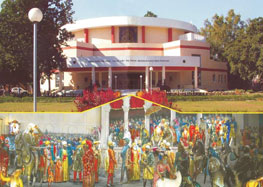
Maharaja Ranjit Singh Panorama
Maharaja Ranjit Singh's reign was also known for all round development, secular values and patriotic fervour. Keeping all these aspects in mind, the Amritsar has come up with many such things that reminds one of Maharaja Ranjit Singh's rule. Maharaja Ranjit Singh
The National Council of Science Museums in cooperation with the State government has recently set up Maharaja Ranjit Singh panorama, which is only second of its kind in the country. Spread on a sprawling 4.5 acres of land in the historic Rambagh heritage Garden, the panorama with its long, cylindrical architecture, is an all-captivating marvel for visitors..

Fort Gobind Garh
The fort was constructed by Maharaja Ranjit Singh in the early 18th century. The construction and design of the fort was to defend against the attacks of the Afghans. The fort is not open to public now. It has been taken over by the Indian security forces.
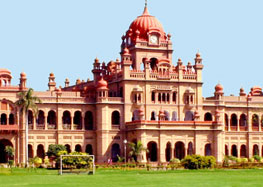
Khalsa College
The oldest college of Amritsar was established in distinctive mix of Mughal and Sikh architecture in the year 1892 by the Singh Sabha Movement. The college campus is spread over more that 300 acres and has that distinctive charm with red minarets and domes against the lush green backdrop.
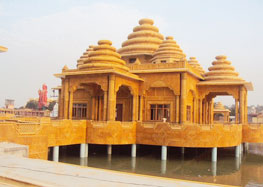
Ram Tirath Temple
Ram Tirath Temple is located at a distance of 11 kilometers West of Chogawan road, Amritsar. The Temple dates back top the period of Ramayana. There is an ancient tank at this place. A number of Temples are scattered in the area. At the site there is a hut where Mata Sita gave birth to Luv and Kush. The site also has Maharishi Valmiki's hermitage and a well with stairs where Mata Sita used to take her bath. The Temples exhibit scenes from Ramayana.
Even in the holy book of Hindus, The Ramayana, the place is mentioned. Sita Mata came here after Lord Rama deserted her and got shelter in Maharishi Valmiki's hermitage. Sage Valmiki trained the children of Lord Ram, Luv and Kush and made them proficient in all fields, be it warfare or religious / social eduction. Annual Fair is held in Ram Tirath in the month of November on the full moon day. The fair lasts for four days.
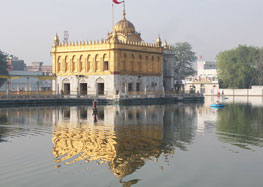
Durgiana Temple
Durgiana Temple is a premier Hindu temple of Punjab (India) situated in the city of Amritsar. This temple derives its name from the Goddess Durga and it is also called by the name of Lakshmi Narayan Temple.
The temple was constructed by Guru Harsai Mal Kapoor on the pattern of the Golden Temple and it is located near the Lohgarh gate. It is sometimes called Silver temple for its carved silver doors. The temple complex has some historic temples such as Sita Mata and Bara Hanuman.
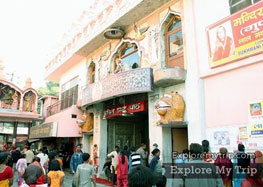
Mata Mandir, Model Town
Amritsar's Mata Mandir Temple was built in the model of the famous Vaishno Devi Temple of Katra, Jammu. The Mata Mandir Temple is an eternal favorite with the Hindu pilgrims and other religiously inclined people too. It has emerged as a popular haunt for the tourists coming to the city as well. Not only it has immense religious sentiments attached to it but it has considerable archaeological importance also.
The Mata Mandir Temple in Amritsar is visited by thousands of devotees and followers every year. The temple witnesses maximum gathering during the festivals. The Mata Mandir Temple is conveniently situated very close to the north western part of Amritsar Railway Station.
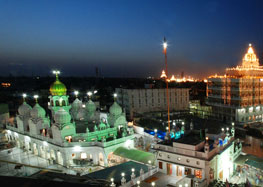
Gurudwara Shaheed Ganj (Shaheedan Sahib)
Baba Deep Singh Shahid (26 January 1682 -13 November 1757), is one of most honoured martyrs in Sikh history. He was the founder of the Shahid Misl (group). He was the first head of Damdami Taksal (Damdama school of learning)[1] a 300 years old religious school of the Sikhs[2] which was founded by last Sikh prophet Guru Gobind Singh.[3][4][5][6] Tall and strong he was an exceptionally brave Sikh. A bold and fearless saint-soldier he was ever ready to risk his life for the Panth. Baba ji was born on January 26, 1682 (some records register this as January 20) and died fighting at Amritsar on November 11, 1757 when he was about 75 years old. From about 12 years of age, he grew up around the tenth Guru, Guru Gobind Singh.